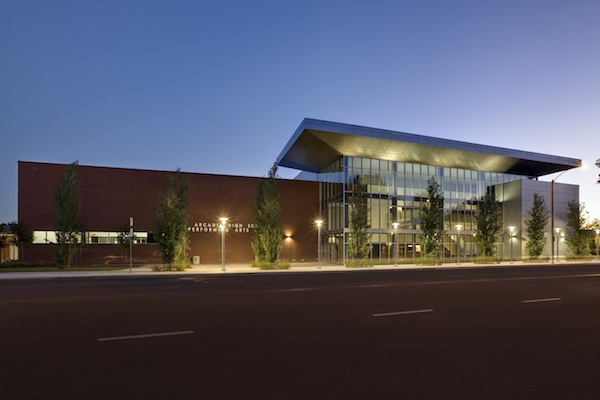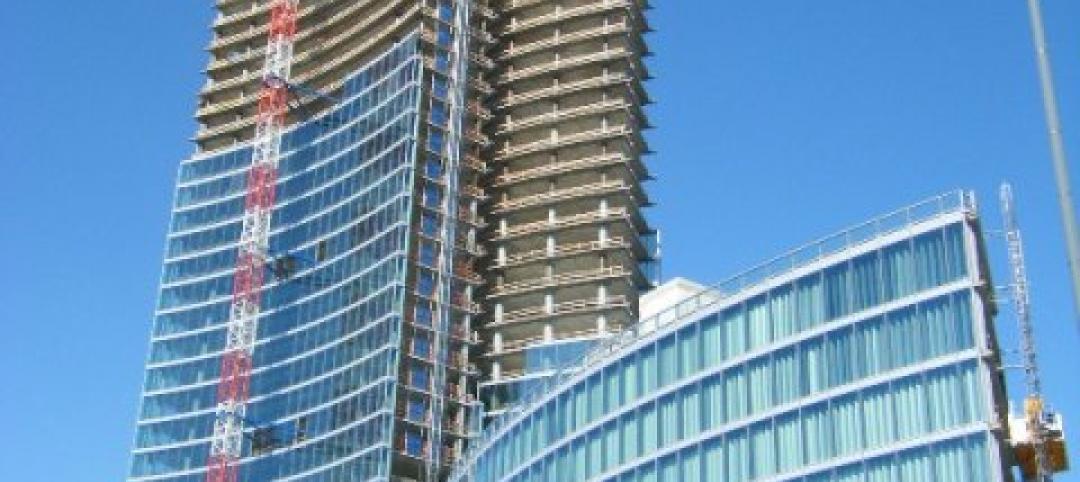A 60-year old wish for the community of Arcadia has finally come true with the opening of Arcadia Unified School District’s new $20 million Performing Arts Center. It was the District’s intent to build an auditorium in 1952 when the high school was originally constructed, but there was no funding. Due to the passage of Bond Measure I in 2006, the District finally had a chance to fulfill this community’s enduring dream.
"We are exceptionally pleased to have realized the dream of providing our students, faculty and community members with a world class performing arts venue that will become a home for the arts in Arcadia,” said AUSD Superintendent Dr. Joel Shawn. “All aspects of the arts are an essential component of a rigorous education for our students and a healthy, vibrant community."
McCarthy Building Companies, Inc., one of Southern California’s foremost building companies specializing in educational facilities, served as general contractor/developer for the facility using Lease/Leaseback project delivery. Constructed on a 4.2 acre site at the northwest end of the Arcadia High School campus, the 40,000 square-foot theater venue opened on October 27, 2012 with an inaugural benefit concert by living music legend Paul Anka.
In addition to being used by the high school for drama, dance and music performances and classes, the new Center will be enjoyed by the entire community, as it is the only performing arts venue in the City of Arcadia. The nonprofit Arcadia Performing Arts Foundation was recently created to support the new center with efforts underway to fund the maintenance and a full-time theater manager for the Center.
Designed by LPA, Inc. the new Performing Arts Center is the latest addition to Arcadia High School’s historic campus. Performing arts, especially music, are extremely important to the Arcadia Unified School District, and this high-concept facility showcases this priority for the Arts through its architecture.
The main performance hall incorporates ground level and mezzanine seating for 1,200 and a stage with capacity for up to 200 musicians. Designed for acoustic performance, this space is equipped with adjustable sound-absorptive panels that allow it to be acoustically “tuned” based on the needs of the performance. In addition, moveable orchestra shells can be utilized to adjust the size of the stage to the performance and the orchestra shell’s acoustical qualities increase the sound projection to the audience. The main hall is also designed with professional lighting and sound systems as well as other state-of-the-art technology making it an exciting venue for the visual arts.
Students can access the main hall from three adjacent classrooms in the Center. Each classroom space has been tailored to instructors’ and students’ needs including a large sound attenuated orchestra room with sound proof practice rooms, instrument storage and a library; a Blackbox/Drama Room with a separate control room and flexible seating for 125 guests; and a Dance Room with a quadruple-sprung wood floor, dressing rooms and a full service backstage facility for scene prop and costumes storage as well as professional stage craft areas. The facility also incorporates a dramatic internal courtyard, lobby and outdoor pavilion areas.
Built with a sloping concrete floor, the steel frame structure features a modern glass, smooth plaster and brick exterior. Interior finishes include cabinetry for music instrument storage, and multiple flooring types such as wood, ceramic tile, carpet, terrazzo and concrete.
Special construction techniques were used to meet the facility’s acoustical and architectural requirements. “A gypsum plaster finish was applied in the theater in lieu of the conventional drywall to increase the density of the walls, along with coffered ceilings in order to provide enhanced acoustical properties within the space,” said McCarthy Project Manager Michael Forys. “We also constructed a 10,000-square-foot scaffold platform to build the 40-foot high ceilings in the main theater.”
Forys noted that the smooth exterior plaster finish provided a unique challenge on the project. “If not finished properly, the exterior walls could look uneven or wavy. To mitigate this challenge, McCarthy spent considerable time with the installing subcontractor reviewing specs, construction details and installation methods prior to the start of the plaster construction to assure that the team would be able to achieve the desired effect in a consistent manner. The proactive quality control for this scope of work helped produce a beautiful end-product exceeding all expectations.”
Forys said that another quality focus of the team was the potential for latent moisture in the concrete slabs that could ultimately effect floor covering adhesion. “Due to recent low VOC legislation changes in the flooring industry, McCarthy has developed a comprehensive flooring coordination program that is utilized to avoid floor issues. In this facility, the program was implemented early in the project and measures were put in place from the foundation on up to reduce concrete slab vapor transmission and maintain the integrity of the finished product,” explained Forys.
“By utilizing Lease/Leaseback procurement of the project, we were able to more effectively work through project challenges during the preconstruction phase that we normally encounter during construction. This alternative delivery also helped to maintain the project budget and provide cost certainty for the District. This was accomplished by conducting a thorough constructability review of the plans while working with the District and design team during preconstruction to create an accurate budget. Also, a lot of time, not normally afforded on hard-bid projects, was spent reviewing the plans and scopes of work with the subcontracting community. This allowed us to provide precise estimates and avoid scope gaps.”
“Delivering high-level of quality was a major priority for this project,” said Forys. “The numerous finish elements (brick, composite aluminum, cement plaster, gypsum plaster, etc.) and their interfaces were all seamlessly integrated. The completed product is a beautiful facility that McCarthy and the District are very proud of and that everyone in the community can enjoy.”
McCarthy is currently overseeing construction projects at 10 elementary and middle schools within the Arcadia Unified School District school facility improvement program including new buildings and modernization.
About McCarthy
Recognized as one of the nation’s few true builders, McCarthy Building Companies, Inc. is the largest educational facilities builder in California (ENR California, July 2012) and the largest general building contractor in California (ENR California, July 2012). The company is committed to the construction of high performance green buildings; progressive job site technology; and safer, faster and more cost-effective execution. In addition to Newport Beach, McCarthy has offices in San Diego, Sacramento and San Francisco, Calif.; Phoenix; Las Vegas; St. Louis; Collinsville, Ill.; Dallas; Houston and Atlanta. McCarthy is 100 percent employee owned. More information about the company is available online at www.mccarthy.com.
Related Stories
| Feb 2, 2012
Call for Entries: 2012 Building Team Awards. Deadline March 2, 2012
Winning projects will be featured in the May issue of BD+C.
| Feb 2, 2012
VLK Architects selected for new Cypress, Texas elementary school
The Bridgeland Elementary School will be a new prototype school for the District. Designed to meet the requirements of The Collaborative for High Performance Schools.
| Feb 2, 2012
Mortenson Construction to build 2.4 MW solar project in North Carolina
Located on a 12 acre site in the Sandhills region, the 2.4 megawatt (MW) system is expected to generate approximately 3.5 million kilowatt hours (kWhs) of clean electricity on an annual basis.
| Feb 2, 2012
Shawmut Design and Construction launches sports venues division
Expansion caps year of growth for Shawmut.
| Feb 2, 2012
Fire rated glazing helps historic university preserve its past
When the University embarked on its first major addition since the opening of Hutchins Hall in 1933, preserving the Collegiate Gothic-style architecture was of utmost importance.
| Feb 2, 2012
Delk joins Gilbane Building Co.
Delk to focus on healthcare construction programs and highly complex higher education facilities for Gilbane Building Company’s Southwest region.
| Feb 2, 2012
Next phase of construction begins on Scripps Prebys Cardiovascular Institute
$456 million Institute will be comprehensive heart center for 21st Century.
| Feb 1, 2012
Increase notched in construction jobs, but unemployment rate still at 16%
AGC officials said that construction employment likely benefited from unseasonably warm weather across much of the country that extended the building season.
| Feb 1, 2012
Replacement windows eliminate weak link in the building envelope
Replacement or retrofit can help keep energy costs from going out the window.
| Feb 1, 2012
‘Augmented reality’ comes to the job site
A new software tool derived from virtual reality is helping Building Teams use the power of BIM models more effectively.















